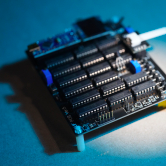

Research Terms
Center for Dental Biomaterials
| Director |
Mateus Rocha, D.D.S., M.S., Ph.D |
| Phone | (352) 273-5845 |
| Website | https://biomaterials.dental.ufl.edu/ |
| Mission | The mission of the Center for Dental Biomaterials is to integrate the research and teaching expertise and the facilities of the Colleges of Dentistry, Medicine, and Engineering at the University of Florida to enhance the development of safe, long lasting, and economical materials to prevent tooth decay and to remineralize, repair or restore demineralized, defective, or damaged tooth structure. |
This antibacterial coating for the titanium screw that attaches the new implant to the bone of the jaw reduces the progression of peri-implant disease, which can lead to bone loss and eventual loss of the implant. Implants are a more common replacement for missing teeth than traditional fixed or removable dental prostheses. Approximately five percent of all dental implants anchored through osseointegration, or the attachment of human bone cells to a metal surface, will fail within ten years. Peri-implantitis, a degenerative, site-specific bacterial infection with no treatment options, causes inflammation of soft-tissue around the implant and bone loss following installation, making it the main cause of failed implants. Available implants traditionally use screws with a coating of titanium-nitride, which reduces corrosion and has good biocompatibility to help osseointegration. However, in those cases where peri-implantitis develops it can lead to loss of bone as well as failure of the implant. Attempts to coat the screw with charged metallic particles with antibacterial properties, such as copper, silver or magnesium, resulted in unfavorable interactions with surrounding tissue.
Researchers at the University of Florida have developed a titanium-nitride coating incorporating an antibacterial layer of quaternary nitrogen that has improved antiseptic properties without using charged metallic ions. Preliminary data indicates that the positively charged quaternized TiN outperforms traditional TiN coatings with a 40-50 percent reduction in bacteria.
Antibacterial dental implant coating that will reduce peri-implant disease and increase implant lifetime
The formation of the antimicrobial layer relies on producing a charged titanium-nitride (TiN) surface through a Menschutkin reaction, which is commonly used to synthesize quaternary ammonium salts. Creation of a charged TiN surface requires three steps. First, a titanium vapor solidifies, forming the titanium layer. Next, a titanium-nitride (TiN) layer forms through evaporation, chemical vapor deposition, plasma spray or sputtering, which coats the titanium layer. Finally, the titanium-nitride (TiN) quarternizes through a reaction of the titanium-nitride layer with an alkyl halide.
This coating for medical implants minimizes surface corrosion and inhibits the formation of bacterial biofilm while maintaining biocompatibility. The global medical device coatings market is expected to reach $17.4 billion in value by 2023 . The largest segment of this market is anti-microbial coatings, which dental or orthopedic implants employ to reduce the risk of infection and need for premature replacement. Implant coatings must inhibit bacterial growth but not impair survival and growth of cells in the recipient tissues. Many available coatings that afford strong antibacterial properties release ions that are toxic to mammalian cells. For dental and orthopedic implants, coatings that have good antibacterial activity, but are also biocompatible as well as providing corrosion-resistance are hard to find.
Researchers at the University of Florida have discovered that a very thin coating of silicon carbide (SiC) prevents the formation of bacterial biofilm without disrupting healthy mammalian cell adhesion or proliferation. The SiC coating has additional corrosion and abrasion resistant properties that increase durability of an implant.
Biocompatible implant coating to protect against bacterial infection and corrosion
The silicon carbide coating applies to an implant surface by plasma-enhanced chemical vapor deposition (PECVD). Quaternizing the SiC coating by adding nitrogen atoms to the SiC surface coatings during PECVD further increases the coating’s antimicrobial properties. The SiC surfaces are corrosion and wear-resistant and exhibit greater hydrophobicity than non-coated surfaces, minimizing the formation of biofilm. In one study, SiC coated materials exhibited a biofilm coverage of 16.9 percent whereas uncoated samples displayed coverage of 91.8 percent after 24 hours.
This prebiotic agent can prevent and treat oral diseases by eliminating disease-causing bacteria, while simultaneously promoting the growth of healthy bacteria. An estimated 3.9 billion people worldwide suffer from oral diseases such as cavities, oral thrush, peri-mucositis and peri-implantitis. These diseases result from an imbalance in the bacterial communities living on the teeth characterized by overabundance of acid-producing, cavity-causing (cariogenic) bacteria at the expense of the bacteria that dislike acidic environments and produce bases. Conventional treatment of oral diseases proceeds by brute force removal of the entire bacterial community, but unfortunately this removes the healthy base-producing bacteria as well as the cavity-causing species they counter. Selectively removing disease-causing bacteria would be a better route to easing the burden of oral diseases.
Researchers at the University of Florida have developed N-Acetyl-Glucosamine (GlcNAc) as an easy-to-use prebiotic remedy for the treatment and prevention of diseases caused by oral bacteria. This treatment selectively targets cavity-causing bacteria by hindering their metabolism, while at the same time acting as a nutrient source for healthy base-producing bacteria. This restores the natural balance of the bacterial community without destroying it, yielding better oral health.
Treatment and prevention of cavities and other oral diseases stemming from imbalanced oral bacteria communities
Common preventable diseases such as cavities and oral thrush stem from an imbalance in the microbes living on the teeth and other oral surfaces in a community known as a biofilm or plaque. This microbiome balances its pH by countering acid-producing bacteria, also called cariogenic bacteria, with base-producing bacteria, also called commensals. However, excessive proliferation of cariogenic bacteria shifts the composition and sugar metabolism of the biofilm, forming an acidic plaque, which eventually causes cavities. Similarly, loss of microbial balance is also the underlying cause of periodontitis and several other oral diseases that are of global public health importance.
Bacteria readily metabolize the prebiotic carbohydrate N-Acetyl-Glucosamine (GlcNAc). During metabolism, GlcNAc induces physiological reprogramming in plaque-producing bacteria that slows acid production, but stimulates commensal bacteria to produce antimicrobial and alkalizing compounds such as hydrogen peroxide H2O2 and ammonia NH3, respectively. These compounds act against the proliferation of cariogenic bacteria and other potential pathogens, providing an additional push toward rebalancing the biofilm.
GlcNAc delivery is versatile enough for both professional and at-home use. For example, administration of GlcNAc in the form of mouthwash or toothpaste can be carried out at home by the patient. Alternatively, a hydrogel formulation can be used less frequently and would be appropriate for patients who are unable to care for themselves.









































